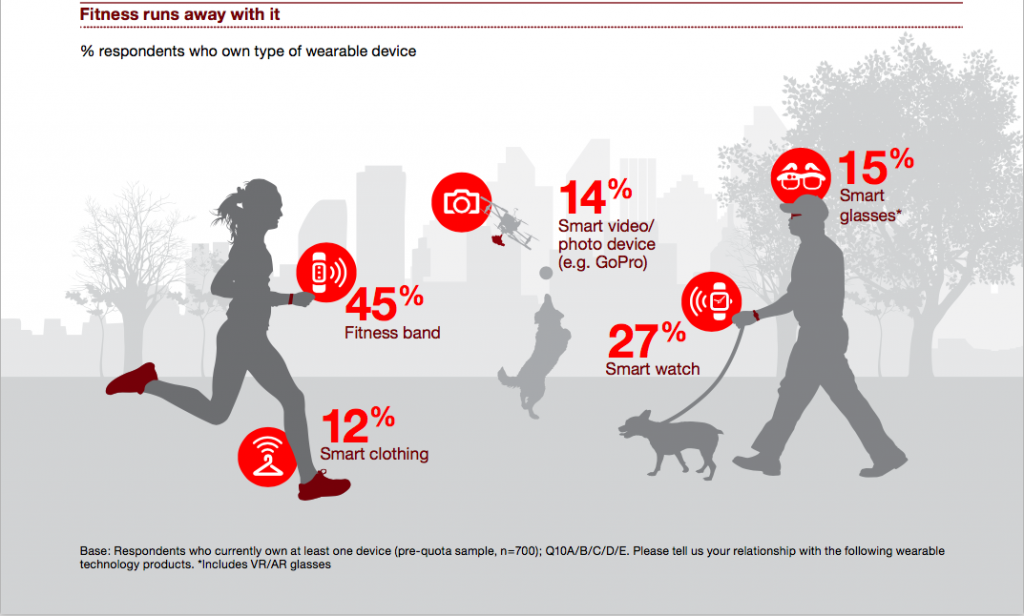![Study Reveals [Shocker] Fitness Driving Wearables Technology](https://bodyhacks.com/wp-content/uploads/2016/05/mann-plus-three-620x300.jpg)
There’s nothing like an in-depth worldwide study on wearables to get me fired up. That, and pancakes.
But back to wearables… Pricewaterhousecoopers, or PwC, started as an accounting agency in London, but now is a global company geared towards finding better business solutions.
As their site states, “We help resolve complex issues and identify opportunities.”
In the case of wearables, they’ve just followed up on their 2014 wearables survey, sampling another 1000 respondents. What’s insane is how much the wearables market has matured since the first study.
As examples, the Apple Watch had yet to be released and Fitbit was just gaining traction. In 2014, Las Vegas Consumer Electronics Expo (CES) only housed a few hundred feet of wearables. By 2016, the wearables exhibit had tripled, consuming center stage.
Amongst other findings, the study reveals what fitness wearables we are currently wearing, compared to two years ago, why we are wearing them, what may be stalling early adopters, and what motivates us to push the limits with these wearables.

(Source: engadget.com)
What fitness wearables we’re wearing.
“Fitness runs away with it,” claims PwC’s report, meaning fitness is the main driver for wearable technology.
The largest category of wearables is fitness bands, taking 45% of the pie. Then smartwatches take another 27%, with (surprise) smart glasses taking the third largest slice at 15%. Smart clothing is 12% of the market, but in two years I imagine this number will jump considerably. Respondents tend to agree.
In 2014, 36% of those surveyed thought clothing would be the future of wearable technology, but in 2016 that number was 54%. Clearly, we all expect our clothes to be something more than just fashionable in the future.

(Source: pwc.com)
Why we are wearing fitness wearables.
Fitness is where this revolution started, and fitness is where it’s still being fought. Health is the number one motivator for wearables purchases. Information that is top of mind for consumers includes exercise data, medical information, dietary tracking.
There are other reasons, though. Despite events like Edward Snowdon’s outing of the NSA, there’s a decreased perception of wearables as a privacy invasion, down seven points from 2014.
Further evidence of privacy sentiments shifting; consumers today are excited about the prospect of their doctor’s office, hospital or health insurance provider releasing a wearable device.
Why we might hesitate to wear fitness wearables.
The number one hesitation for fitness wearables is the price, not the privacy concern. That comes in third place, right behind the concern that they simply may not use it.
The report from PwC points out that wearables are not “turn around possessions,” where you would go back home if you forgot them, like for a cellphone.
We also have concerns about device fatigue, like batteries dying or the speed of technology making devices obsolete. We worry about the lack of relevance. Solve these, then we may be onto something.
If fitness devices of the future are more affordable, more relevant, we may start to view them like we view wallets. In fact, companies like Jawbone may be onto that very solution, adding near field communication (NFC or payment ability) into their UP4 fitness tracker.
What motivates us to push our fitness limits with wearables?
Respondents to the survey cite the prospect of monetary rewards as the best potential motivator for adherence to their wearables, with 54% ranking this as #1.
While that sounds like a long shot, nobody should be surprised that people picked money. It’s not too far-fetched, though. Supermarkets figured out a way to give shoppers the perception of money-back through rewards programs, which ironically only drive up the prices for food, but the perceptions are money-saving opportunities.
Maybe wearables can figure out a similar system? Considering that “gaming features,” and “providing users with the unique information they would not have otherwise” tied for second place, maybe they can all be tied into one solution?
The first few years SUVs grew in popularity, nobody was sure what to call them. We’d had vehicles like this for decades, but we had no single way to talk about them. Famously, in the movie Goonies (1985) they used the term ORV, which sounds silly today.
As wearables move from devices to our everyday wear, will the term “wearables” start to sound antiquated like ORV? I think so.
The perception of respondents leaning towards heavy changes in clothing wearables implies that none of us will be surprised to hand in the term wearables for another term we’ve been using for centuries…
Clothing.



